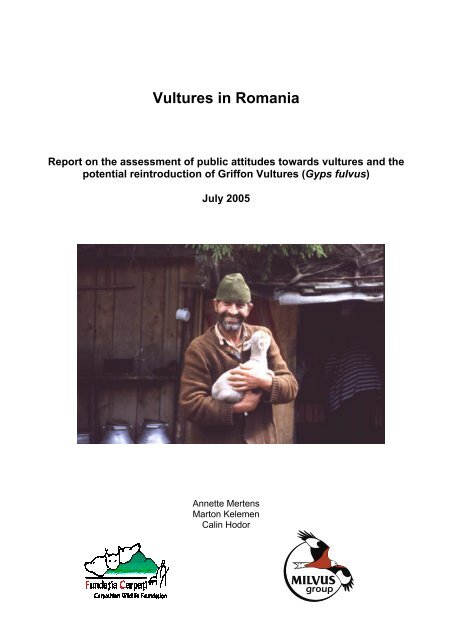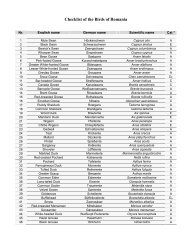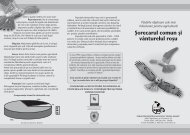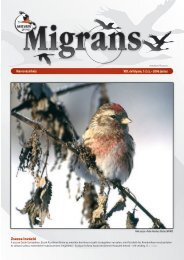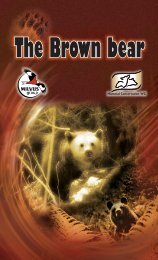Vulture in Romania - Milvus Group
Vulture in Romania - Milvus Group
Vulture in Romania - Milvus Group
You also want an ePaper? Increase the reach of your titles
YUMPU automatically turns print PDFs into web optimized ePapers that Google loves.
<strong>Vulture</strong>s <strong>in</strong> <strong>Romania</strong><br />
Report on the assessment of public attitudes towards vultures and the<br />
potential re<strong>in</strong>troduction of Griffon <strong>Vulture</strong>s (Gyps fulvus)<br />
July 2005<br />
Annette Mertens<br />
Marton Kelemen<br />
Cal<strong>in</strong> Hodor
Introduction<br />
<strong>Romania</strong> has been home to significant vulture populations up to the first decades of the 20th<br />
century. All four European vulture species (Gypaetus barbatus, Gyps fulvus, Aegypius monachus,<br />
Neophron percnopterus) are reported to have existed <strong>in</strong> this country. The birds used to be<br />
widespread all over the <strong>Romania</strong>n Carpathians but ma<strong>in</strong>ly concentrated <strong>in</strong> mounta<strong>in</strong> ranges with<br />
extensive rocky areas such as the Bucegi and Piatra Craiului Massifs (<strong>in</strong> the Curvature<br />
Carpathians), the Retezat Massif (<strong>in</strong> the Sourthern Carpathians) and the Ceahlau Massif (<strong>in</strong> the<br />
Eastern Carpathians). However, all four species are now ext<strong>in</strong>ct <strong>in</strong> <strong>Romania</strong> although occasional<br />
sight<strong>in</strong>gs of Egyptian <strong>Vulture</strong>s occur <strong>in</strong> the Southern part of the country. The causes for the<br />
population decrease and ext<strong>in</strong>ction of all the species seemed to be ma<strong>in</strong>ly collection of eggs and<br />
poison<strong>in</strong>g.<br />
Successful vulture re<strong>in</strong>troductions and population restock<strong>in</strong>g programs have been done <strong>in</strong> several<br />
sites <strong>in</strong> Europe. The experience from these projects has shown that the most successful procedure<br />
is to beg<strong>in</strong> with a re<strong>in</strong>troduction of the Griffon <strong>Vulture</strong> and then, on the long term, eventually<br />
attempt the re<strong>in</strong>troduction of the other species.<br />
One of the ma<strong>in</strong> conditions for a successful re<strong>in</strong>troduction and the conservation of a species is the<br />
support of the local human population. Consider<strong>in</strong>g that <strong>in</strong> <strong>Romania</strong> vultures have been eradicated<br />
by humans it can be assumed that if the necessary public support does not exist locals might<br />
jeopardize the existence of these species <strong>in</strong> this country a second time. It is therefore of primary<br />
importance to know whether the local communities would support a potential re<strong>in</strong>troduction, under<br />
which conditions, and how to <strong>in</strong>crease this support as much as possible.<br />
Dur<strong>in</strong>g several conversations that the project staff has had with local <strong>in</strong>habitants the assumption<br />
arose that these generally have a problem <strong>in</strong> dist<strong>in</strong>guish<strong>in</strong>g vultures from eagles or other large<br />
raptors, which is why most of the people believe that vultures are dangerous for livestock. This can<br />
be a threat for vultures s<strong>in</strong>ce people might to fight the birds <strong>in</strong> order to reduce livestock<br />
depredation.<br />
Therefore, <strong>in</strong> the frame of the project “<strong>Vulture</strong> <strong>in</strong> <strong>Romania</strong>” a public op<strong>in</strong>ion survey was performed<br />
among the <strong>in</strong>habitants of the towns and villages <strong>in</strong> the Retezat National Park. In July 2005 292<br />
people were <strong>in</strong>terviewed with the help of a specific questionnaire. The survey revealed that <strong>in</strong> fact<br />
people seem to be scarcely able to dist<strong>in</strong>guish between vultures and eagles. Still, the general<br />
attitude towards vultures was relatively positive and there was little opposition towards a potential<br />
re<strong>in</strong>troduction.
Study area<br />
The op<strong>in</strong>ion poll was carried out <strong>in</strong> settlements with<strong>in</strong> the border of the Retezat National Park.<br />
Cover<strong>in</strong>g a surface of 38,000 ha, of which 1,800 ha are strictly protected area, it is located <strong>in</strong> the<br />
County of Hunedoara, south of the city of Deva, <strong>in</strong> the Southern Carpathians. Altitudes range from<br />
900 to 2509 m (Mount Peleaga). The vegetation of the forests consists pr<strong>in</strong>cipally of beech (Fagus<br />
sp.), conifers (spruce [Picea abies] and fir [Abies alba]), oak (Quercus sp., 18%) and mounta<strong>in</strong><br />
maple (Acer pseudoplatanus). The lower hills are covered by beech or mixed beech–conifer<br />
forests, whereas the vegetation of the higher areas is made up ma<strong>in</strong>ly by spruce forests. The<br />
ranges above the timberl<strong>in</strong>e (above 1,900 m) consist of rock ranges and of mounta<strong>in</strong> pastures that<br />
are widely used for livestock rais<strong>in</strong>g.<br />
Both from the po<strong>in</strong>t of view of flora and fauna the <strong>Romania</strong>n Carpathians hold an extremely high<br />
biodiversity, with many endemic and subendemic species. There are 1650 plant species, almost<br />
half of the <strong>Romania</strong>n flora, <strong>in</strong> over 200 vegetal associations. Of the total <strong>Romania</strong>n fauna more<br />
than 1,000 species are considered endemic although the geographical distribution of many of<br />
these species is only poorly known. The country hosts more than 33,000 species, sub-species and<br />
varieties of animals, out of which 33,085 <strong>in</strong>vertebrates and 707 vertebrates. Except for the bison<br />
(Bison bonasus) and elk (Alces alces) all the orig<strong>in</strong>al large mammal fauna is still present <strong>in</strong><br />
<strong>Romania</strong>. Wolves, bears and lynx are the ma<strong>in</strong> predator species, red deer (Cervus cervus), roe<br />
deer (Capreolus capreolus), wild boars (Sus scrofa), and chamois (Rupicapra rupicapra) the ma<strong>in</strong><br />
prey species. To a small degree, wild cats (Felis sylvestris) prey on roe deer. In the past couple of<br />
years also golden jackals (Canis aureus) have shown up <strong>in</strong> the Carpathians. Also among the birds<br />
some species are present which are rare <strong>in</strong> other European countries, like the raven (Corvus<br />
corax), the cappercaillie (Tetrao urogallus), the golden eagle (Aquila chrysaetos), whereas only few<br />
species, such as all the vultures, are ext<strong>in</strong>ct.<br />
With<strong>in</strong> the territory of the Retezat National Park there are 24 communes, subdivided <strong>in</strong>to villages<br />
that are scattered ma<strong>in</strong>ly <strong>in</strong> valleys north and south of the ma<strong>in</strong> mounta<strong>in</strong> massif. Generally, socioeconomic<br />
conditions of the locals are very simple and <strong>in</strong>frastructures are poor. Similarly to the rest<br />
of the <strong>Romania</strong>n Carpathians traditional agricultural activities are still widely <strong>in</strong> practice <strong>in</strong> and<br />
around the park. These consist ma<strong>in</strong>ly <strong>in</strong> traditional livestock production, especially sheep<br />
husbandry.
Methods<br />
In July 2005 a questionnaire was adm<strong>in</strong>istered to 292 persons over the age of 18, <strong>in</strong> 9 communes<br />
and 28 villages (20 <strong>in</strong>terviews <strong>in</strong> each commune, 4 <strong>in</strong>terviews <strong>in</strong> each village) <strong>in</strong> the territory of the<br />
Retezat National Park. In each settlement the people to which the questionnaires were submitted<br />
were chose casually. The <strong>in</strong>terviewers started from randomly chosen po<strong>in</strong>ts, then they selected<br />
every third house or apartment. If more than one person was present <strong>in</strong> the household at the<br />
moment of the <strong>in</strong>terview, the person with the closest birthday was chosen as the respondent. If<br />
nobody was home or the present people refused to answer the questionnaire, the <strong>in</strong>terviewer went<br />
on to the next house/apartment. The questions were asked and the answers recorded by the<br />
<strong>in</strong>terviewer.<br />
The <strong>in</strong>terviews were carried out by two students of the University of Cluj Napoca, with the logistical<br />
assistance of the personnel of the RNP.<br />
The questionnaire consisted of 50 questions plus 7 additional questions concern<strong>in</strong>g generic<br />
<strong>in</strong>formation about the respondents. It was divided <strong>in</strong>to 5 sections: (1) 9 questions to assess the<br />
respondents’ capacity to identify vultures, (2) 10 questions about the respondents’ general<br />
knowledge about the ecology of vultures, (3) 10 questions on the knowledge of the respondents<br />
about the ext<strong>in</strong>ction of the species <strong>in</strong> <strong>Romania</strong>, (4) 15 questions on the general attitudes about<br />
vultures and (5) 6 questions explor<strong>in</strong>g the attitudes of the respondents towards a potential<br />
re<strong>in</strong>troduction.<br />
Three different scales were used for different groups of questions:<br />
Questions with possible answers rang<strong>in</strong>g from “strongly disagree” or “strongly dislike” (1 po<strong>in</strong>t)<br />
to “strongly agree” or “strongly like” (5 po<strong>in</strong>ts).<br />
Questions which answers were “yes”, (1 po<strong>in</strong>t), “no” (2 po<strong>in</strong>ts) and “don‘t know” (3 po<strong>in</strong>ts).<br />
The question about the level of <strong>in</strong>terest of the respondents towards vultures was ranked on a<br />
scale from 1 to 10 (1 = Not at all <strong>in</strong>terested; 10 = Very <strong>in</strong>terested).<br />
Dur<strong>in</strong>g the <strong>in</strong>terview a panel with pictures of four bird species (Golden eagle (Aquila chrysaetos),<br />
Griffon vulture (Gyps fulvus), Balck stork (Ciconia nigra), Buzzard (Buteo buteo)) (Annex II) was<br />
shown to the <strong>in</strong>terviewee and the respondent was asked to identify the four species.<br />
Data analysis<br />
In order to analyse the attitudes of the respondents to certa<strong>in</strong> sets of questions these questions<br />
were pooled and a medium score was calculated. To assess the knowledge of the respondents the<br />
questions were subdivided as follows:<br />
1. What do vultures eat?<br />
2. Feed<strong>in</strong>g behaviour score: (Statements to be answered with “true”, “false”, “don’t know”)<br />
<strong>Vulture</strong>s are predators<br />
<strong>Vulture</strong>s kill animals to eat them<br />
<strong>Vulture</strong>s feed on dead animals<br />
<strong>Vulture</strong>s kill livestock<br />
3. General ecology score: (Statements to be answered with “true”, “false”, “don’t know”)<br />
Griffon vultures live <strong>in</strong> groups<br />
Griffon vultures nest <strong>in</strong> rocks<br />
Griffon vultures use warm air to fly<br />
Griffon vultures don’t see well<br />
4. Do vultures attack people? (Statements to be answered with “yes”, “no”, “don’t know”)<br />
5. Total knowledge score: All the previous questions pooled together
The score of the respondents’ op<strong>in</strong>ion about the importance of vultures was calculated from<br />
questions pooled as follows:<br />
<strong>Vulture</strong>s are important for nature<br />
<strong>Vulture</strong>s are a richness for <strong>Romania</strong><br />
It’s important for me that vultures exist <strong>in</strong> <strong>Romania</strong><br />
For test<strong>in</strong>g for different attitudes between groups of respondents we used the χ 2 test whereas for<br />
check<strong>in</strong>g for correlation between different factors we used Spearman correlation.
Results<br />
General <strong>in</strong>formation<br />
In the course of the op<strong>in</strong>ion poll 292 persons were <strong>in</strong>terviewed <strong>in</strong> the area of the Retezat National<br />
Park, of which 63% were men and 37% were women. Of the <strong>in</strong>terviewees 41% were livestock<br />
raisers, 11,5% were hunters, 2% were foresters and 45,3% farmers. Of the people who owned<br />
livestock 76% owned cattle, 71,2% owned pigs, 33,5% owned horses, 27,5% owned sheep and<br />
1,8% owned donkeys, goats and hares. The average age of the <strong>in</strong>terviewees was 47,8 years,<br />
rang<strong>in</strong>g from 18 to 82.<br />
Identification<br />
Most <strong>in</strong>terviewees (99,3%) stated that they knew what a vulture is and more then half (65,2%)<br />
stated that they knew what an eagle is. However, only 45% of the people stated that they knew the<br />
difference between eagles and vultures, and only 34% of these told a difference that can be<br />
considered to be correct (Tab. 1).<br />
Table 1. Differences between vultures and eagles accord<strong>in</strong>g to the declarations of the <strong>in</strong>terviewees<br />
Differences Number of times mentioned<br />
<strong>Vulture</strong> is bigger 16<br />
<strong>Vulture</strong> is smaller 31<br />
<strong>Vulture</strong> lives <strong>in</strong> lower altitudes 2<br />
<strong>Vulture</strong> feeds on carcasses, eagles on live animals 2<br />
<strong>Vulture</strong> has naked neck and is smaller 1<br />
<strong>Vulture</strong> has bigger bill 1<br />
<strong>Vulture</strong> has longer w<strong>in</strong>gs 2<br />
Eagle has shorter tail 1<br />
Shape 1<br />
Colour 6<br />
Different head 1<br />
Other hunt<strong>in</strong>g style 1<br />
Eagles are more predators 4<br />
<strong>Vulture</strong> has bent bill 2<br />
Eagle has naked neck 1<br />
Eagle has straighter w<strong>in</strong>gs 1<br />
Eagle is a night hunter 1<br />
Also, when asked to determ<strong>in</strong>e four species from pictures they were shown, only 16,1% of the<br />
<strong>in</strong>terviewees correctly identified an eagle and 55% identified a vulture (Fig.1). Moreover, of the<br />
people who identified a wrong species 104 stated that the eagle was a vulture and 34 stated that<br />
the vulture was an eagle.<br />
The χ 2 test revealed a significant difference <strong>in</strong> the number of people who correctly identified the<br />
griffon vulture among the four professional groups (χ 2 = 7,98; df 3; p = 0,46), given by the fact that<br />
foresters gave more correct answers (75%) than livestock raisers (49%), hunters (53,3%) and<br />
farmers (55,3%).
60<br />
50<br />
40<br />
30<br />
20<br />
10<br />
0<br />
Eagle <strong>Vulture</strong> Stork Buzzard<br />
Right Wrong Don't know<br />
Figure 1. Number of people that were able or unable to identify the four species that were shown<br />
on pictures<br />
Very heterogeneous def<strong>in</strong>itions were given to the four species that were requested to be identified<br />
(Fig. 2), rang<strong>in</strong>g from mammals (bats) to exotic bird species.<br />
Figure 2. Number of times different def<strong>in</strong>itions<br />
were given to the species that were asked to be<br />
identified on pictures
Knowledge about the ecology of vultures<br />
Most of the respondents (63,2%) were aware of the fact that vultures are carnivores whereas<br />
32,9% replied that vultures feed both on vegetables and meat. However, the knowledge score<br />
about feed<strong>in</strong>g behaviour was relatively low (38,97% of questions answered correctly). This low<br />
score was ma<strong>in</strong>ly due to the fact that most of the respondents believed that vultures are predators<br />
(80,4%) and that they kill animals to feed on them (76,9%). Contrarily, a big proportion of the<br />
people (76,5%) were aware that vultures feed on dead animals whereas half (44,9%) believe that<br />
vultures do kill livestock. Contrarily to what could have been expected more hunters and farmers<br />
than livestock raisers believe that vultures kill livestock, but the difference was not significant (χ 2 =<br />
5,36; df 3; p = 0,146). There was no significant difference between knowledge scores about food<br />
habits of griffon vultures between different professions of the <strong>in</strong>terviewees (χ 2 = 0,005; df 3; p =<br />
0,99).<br />
In the section about general ecology of vultures the knowledge score was slightly higher (57,5% of<br />
the questions answered correctly). The ma<strong>in</strong> question answered wrongly was whether vultures live<br />
<strong>in</strong> groups, where only 14,7% of the people gave a correct answer.<br />
The total knowledge score (52,56% of the questions answered correctly) was <strong>in</strong> addition <strong>in</strong>creased<br />
by the fact that most of the people (78,6%) answered correctly that vultures do not attack people.<br />
No significant difference appeared <strong>in</strong> the total knowledge scores of the four professional groups (χ 2<br />
= 0,25; df 3; p = 0,97).<br />
Ext<strong>in</strong>ction of vultures<br />
To the question “do you th<strong>in</strong>k vultures still exist here?” over half of the people (52,3%) gave a<br />
positive, <strong>in</strong>correct answer. Of these, almost half (43,5%) stated that they have seen vultures lately,<br />
two of them stat<strong>in</strong>g that they saw one <strong>in</strong> their courtyard. Of the people that believe that vultures are<br />
not present <strong>in</strong> <strong>Romania</strong> most (78%) believe that the ext<strong>in</strong>ction of vultures is a loss for the country.<br />
When asked what they believed is the cause for the ext<strong>in</strong>ction of griffon vulture, most of the<br />
respondents (28,2%) mentioned shoot<strong>in</strong>g, whereas the collection of eggs, which is actually one of<br />
the important causes, was mentioned by only 7,4% of the respondents (Fig. 3).<br />
Reasons for ext<strong>in</strong>ction of Griffon vultures as<br />
mentioned by the respondents<br />
Shoot<strong>in</strong>g<br />
Diseases<br />
Lack of places to live<br />
Lack of food<br />
Poison<strong>in</strong>g<br />
Collection of eggs<br />
Climate change<br />
Forest cuts<br />
Tourism<br />
Pollution<br />
0 20 40 60 80 100<br />
Number of respondents<br />
Figure 3. Different reasons for the ext<strong>in</strong>ction of Griffon vultures mentioned by the respondents of<br />
the op<strong>in</strong>ion poll
Attitudes towards vultures<br />
The <strong>in</strong>terests of the respondents towards vultures resulted to be medium, (5,21 on a scale from 1<br />
to 10), as was also the general attitude (3,62 on a scale from 1 to 5). This second parameter<br />
appeared to be strongly correlated with the knowledge scores (the number of correct answers <strong>in</strong><br />
the knowledge section) (Spearman: rs = 0,24; p = 0,000).<br />
The score about the importance of vultures for nature and for <strong>Romania</strong> was relatively high (Fig. 4)<br />
and only few people believe that <strong>in</strong> <strong>Romania</strong> there are too many vultures (4,82%).<br />
It is important for<br />
me that vultures<br />
exist<br />
<strong>Vulture</strong>s are a<br />
richness for<br />
<strong>Romania</strong><br />
<strong>Vulture</strong>s are<br />
important for<br />
nature<br />
0% 20% 40% 60% 80% 100%<br />
Agree Disagree<br />
Figure 4. Number of respondents that agree/disagree with statements about the importance of<br />
vultures for nature and <strong>Romania</strong><br />
Also, the respondents generally considered vultures not to be a danger for people (1,6 on a scale<br />
from 1 to 5) and only very few people (11,38%) stated that they are scared of these birds.<br />
The belief that vultures cause damage on agriculture was low (1,58 on a scale from 1 to 5)<br />
whereas the belief that these animals are a danger for livestock was higher (2,39 on a scale from 1<br />
to 5). But when asked which species, vultures, eagles, buzzards or ravens, <strong>in</strong> their op<strong>in</strong>ion is most<br />
dangerous for livestock, the respondents did not po<strong>in</strong>t out vultures (Fig. 5). The belief that these<br />
birds are a danger for domestic animals was <strong>in</strong>versely proportional to the total knowledge score of<br />
the respondents (Spearman: rs = -0,33; p = 0,000).<br />
Number of times the species was<br />
mentioned to be the most dangrous<br />
for livestock<br />
60<br />
50<br />
40<br />
30<br />
20<br />
10<br />
0<br />
<strong>Vulture</strong>s Eagles Buzzard Raven<br />
Figure 5. Number of times the respondents mentioned the different species to be most dangerous<br />
for livestock
<strong>Vulture</strong> re<strong>in</strong>troduction<br />
Most of the <strong>in</strong>terviewees (88,7%) stated that they would agree if a vulture re<strong>in</strong>troduction was tried<br />
<strong>in</strong> the Retezat Mounta<strong>in</strong>s and most of them (79,8%) said that they would be happy if these birds<br />
would exist aga<strong>in</strong> <strong>in</strong> the area where they live. Also, only few people (5,8%) would be scared of this<br />
option. The number of people that agree with a re<strong>in</strong>troduction did not vary significantly among the<br />
three classes of knowledge levels (0-1 correct answers; 4-6 correct answers; 7-9 correct answers)<br />
(χ 2 = 1,97; df 2; p = 0,37).<br />
Contrarily to the previously mentioned belief that vultures <strong>in</strong> general are a danger to livestock only<br />
few of the respondents (16,8%) stated that they believe that the presence of vultures would cause<br />
problem to livestock.<br />
When asked whether <strong>in</strong> their op<strong>in</strong>ion a vulture re<strong>in</strong>troduction would be possible most of the<br />
respondents (81,3%) gave a positive answer. In the few cases <strong>in</strong> which people did not believe that<br />
this is possible almost all the reasons were bonded to socio-economic or policy reasons and only<br />
few ones about ecological issues (Tab. 2).<br />
Table 2. Reasons for which the respondents believed that a re<strong>in</strong>troduction of Griffon <strong>Vulture</strong> <strong>in</strong><br />
Retezat National Park is not feasible<br />
Because they damage livestock<br />
Because good th<strong>in</strong>gs are not done here<br />
Because they are not shy enough<br />
There are no conditions (not specified)<br />
Because nobody is <strong>in</strong>terested <strong>in</strong> them<br />
Because nobody would agree<br />
Because of the mentality of the governors<br />
Because of f<strong>in</strong>ancial reasons
Conclusions<br />
The results of the part of the op<strong>in</strong>ion poll that explored the capacities of the respondents to identify<br />
different bird species, among which vultures and eagles, <strong>in</strong>dicate that <strong>in</strong> general quite consistent<br />
confusion is made between these two species/groups of species. Also <strong>in</strong> general, the knowledge<br />
about bird species appeared to be relatively low, consider<strong>in</strong>g that all the species that were asked to<br />
be identified (except for the Griffon vulture) are species that are commonly found <strong>in</strong> the study area.<br />
The fact that the Capercaillie was mentioned by several respondents can be expla<strong>in</strong>ed by the fact<br />
that this bird is common <strong>in</strong> the Carpathians and is an important game species <strong>in</strong> the area.<br />
Contrarily, also exotic species were named (pengu<strong>in</strong>, parrot, peacock), which suggests that the<br />
knowledge of people about birds might be <strong>in</strong>fluenced by the mass media. Foresters appeared to<br />
have a better capability to dist<strong>in</strong>guish vultures from eagles, which is expectable due to their<br />
professional activities.<br />
The hypothesis that many people are unable to dist<strong>in</strong>guish between eagles and vultures is<br />
supported by the fact that the knowledge score about feed<strong>in</strong>g behaviour was low. In fact the<br />
majority of the respondents wrongly stated that vultures are predators and that they kill animals to<br />
feed on them. Also, half of them stated that these birds kill livestock. All these are typical<br />
characteristics of eagles.<br />
This is even further supported by the fact that most people wrongly believed that vultures are<br />
solitary (which <strong>in</strong>stead is true for eagles), whereas the other three questions of the section “general<br />
ecology”, which correct answers apply also to eagles, were more often answered correctly.<br />
These f<strong>in</strong>d<strong>in</strong>gs are extremely important for a potential re<strong>in</strong>troduction of Griffon vulture <strong>in</strong> <strong>Romania</strong><br />
because they <strong>in</strong>dicate that there is a strong need for people to be <strong>in</strong>formed about the difference<br />
between birds of prey and vultures, equally across the professional categories.<br />
The importance of public <strong>in</strong>formation about vultures is also supported by the correlation that<br />
appeared to exist between the attitudes of people towards these animals and the general<br />
knowledge, and by the <strong>in</strong>verse correlation between knowledge and the belief that these birds kill<br />
livestock.<br />
The generally positive attitude towards vultures and the lack of resistance towards a re<strong>in</strong>troduction<br />
is remarkable consider<strong>in</strong>g that all four vulture species have been eradicated from <strong>Romania</strong> by<br />
humans and consider<strong>in</strong>g that re<strong>in</strong>troductions often do meet strong resistance by local communities.<br />
This is even more remarkable <strong>in</strong> the light of the fact that most respondents believed that a<br />
re<strong>in</strong>troduction is possible and thus apparently this option is considered realistic.<br />
This fact is encourag<strong>in</strong>g for a potential re<strong>in</strong>troduction. However, it should be kept on m<strong>in</strong>d that<br />
some prejudice towards vultures does exist, such as the fact that they kill livestock. Such k<strong>in</strong>d of<br />
wrong belief can easily become a driv<strong>in</strong>g force for oppos<strong>in</strong>g a potential population once the<br />
animals are really present. Also, the fact that apparently vultures and eagles are mixed up calls for<br />
strong carefulness s<strong>in</strong>ce it suggests that many people might not be view<strong>in</strong>g a potential vulture<br />
re<strong>in</strong>troduction realistically.<br />
Therefore it is strongly recommendable that whatever steps are done for re<strong>in</strong>troduc<strong>in</strong>g vultures <strong>in</strong><br />
the Retezat Mounta<strong>in</strong>s (or <strong>in</strong> other areas <strong>in</strong> the Carpathians), the attitudes of the local <strong>in</strong>habitants<br />
are constantly monitored, that an <strong>in</strong>-depth <strong>in</strong>formation campaign about vultures and other raptors is<br />
made and that the local communities are permanently <strong>in</strong>formed about the steps that are be<strong>in</strong>g<br />
taken.


